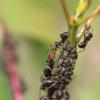So while observing my Formica subsericea colony, I noticed that there is a significant size difference between some pupae. The larger ones are as big as the current workers or bigger, while the smaller ones are like half the size of the larger ones. I've been feeding them plenty of protein. As far as I know, Formica isn't polymorphic. Is there a reason behind this? The pupae are a mix of cocoons and exarate pupae, if that info helps.
- Formiculture.com
- Forums
- Gallery
- Members
- Member Map
- Chat























